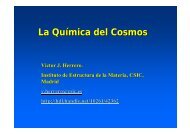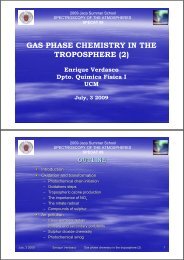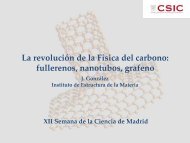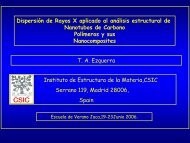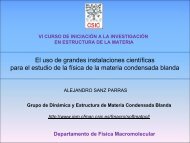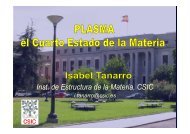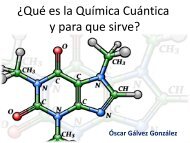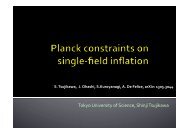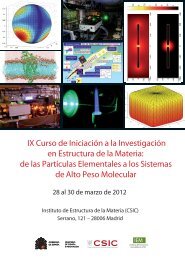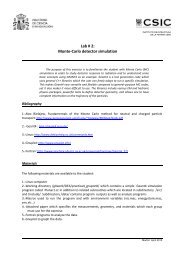ANNUAL REPORT 2011 - Instituto de Estructura de la Materia
ANNUAL REPORT 2011 - Instituto de Estructura de la Materia
ANNUAL REPORT 2011 - Instituto de Estructura de la Materia
Create successful ePaper yourself
Turn your PDF publications into a flip-book with our unique Google optimized e-Paper software.
with the extracellu<strong>la</strong>r ERBBs domains in parallel with experimental studies. The objective is to know <strong>de</strong>tailedstructural and dynamics characteristics about the receptors in or<strong>de</strong>r to <strong>de</strong>sign new and more effective therapies.AS-48 bacteriocin mechanism of action.Small pepti<strong>de</strong>s containing α-helix secondary structure have beeni<strong>de</strong>ntified as antimicrobial agents in various organisms. The mechanism by which a soluble pepti<strong>de</strong> is converted to abacterial membrane bound protein is essential to un<strong>de</strong>rstand their toxicity. AS-48 is a 70 residue cyclic bacteriocin.It is produced by Enterococcus faecalis and is unique by its cyclic structure and its ample antimicrobian spectraincluding Gram-positive and Gram-negative bacteria. These facts suggest that AS-48 can be a good candidate to anatural food preservative. The primary AS-48 objective is the bacterial membrane where it apparently forms poresgiving rise to membrane permeability. In our research group we are carrying out molecu<strong>la</strong>r dynamics simu<strong>la</strong>tions onsystems composed of several AS-48 protomers and lipid bi<strong>la</strong>yer as representative of the bacterial membrane in or<strong>de</strong>rto shed light about the bactericidal mechanism of AS-48.BIOPHYSICS: THREE-DIMENSIONALSTRUCTURE AND HYDRODYNAMICS OF PROTEINS ANDBIOMACROMOLECULAR COMPLEXESThe study of structure and biophysical properties of biomacromolecu<strong>la</strong>r complexes as proteins leads to a <strong>de</strong>eperknowledge about their function in their biological context. With this purpose in mind we have studied proteinsimplicated in eukaryotic signalling pathways by three dimensional electron microscopy and dynamic lightscattering. Our results, obtained in col<strong>la</strong>boration with other groups at the Department of Crystallography andStructural Bilogy (IQFR/CSIC) and international <strong>la</strong>boratories as Sino Biological Ltd. in Beijing, have shown theglobal dimensions of these macromolecu<strong>la</strong>r complexes and have <strong>de</strong>scribed their spatial arrangement. Themacromolecules studied are involved in important cell processes as external signal <strong>de</strong>tection, environmentadaptation and cellu<strong>la</strong>r transformation. The structural analysis of these biomacromolecules will shed light on howthey work into the cell.FORCE FIELD DEVELOPMENT FOR IONIC LIQUIDSIonic liquids (ILs) are salts ma<strong>de</strong> from an immense number of combinations of different cations and anions. Thus,ILs can be tailored for <strong>de</strong>sired physicochemical properties which are of great interest for many industrial processes.In the present case, we have investigated the [EMIM] + [B(CN) 4 ] - IL due to its attractive thermophysical propertiessuch as a very low viscosity as well as a high chemical and thermal stability. Three united atom force fields were<strong>de</strong>veloped for this IL by fitting the electrostatic potential surface of the stable ion-pair configurations using the EA-RESP procedure. Density results were in good agreement with experimental data over a broad temperaturerange.Refinement of the anionic LJ energy parameters in FF-3 allowed a further improvement of the transportproperties closer to experimental data. In the future, the transferability of the <strong>de</strong>veloped FF-3 will be investigatedfor longer alkyl chains of the cation. This work has been accomplished in col<strong>la</strong>boration with Prof. IoannisEconomou (The Petroleum Institute, United Arab Emirates), Dr. Nuno Garrido (Universida<strong>de</strong> do Porto), Dr.Andreas Fröba and Mr. Thomas Köller (University of Er<strong>la</strong>ngen-Nuremberg).TRANSMISION ELECTRON MICROSCOPY at BIOPHYMThe TEM-BIOPHYM facility has been used to analyze several materials from scientific <strong>la</strong>bs belonging to IQFR,ICTP and IEM (CSIC). The measurements were oriented to shed light on the structural <strong>de</strong>tails of nanoparticles,polymeric materials and/or composites of them. The samples were analyzed as single particles dispersed on the gridsurface or as ultrathin sections. Following are listed some of the systems studied:-P<strong>la</strong>tinum, silver, gold and metal oxi<strong>de</strong> nanoparticles.-Gold nanoparticles coated with silica and magnetite nanoparticles coated with with gold, silver and silica.-Quantum dots.-Ultrathin sections of polymeric matrixes with different nanoparticles (i.e. carbon nanoparticles).-Micelles and polymeric vesicles.-Nanocomposites of titanium.The main purpose of these measurements was to know the nanostructure of the nanopartiles particles or theirdispersion and organization into the polymeric matrixes.78




